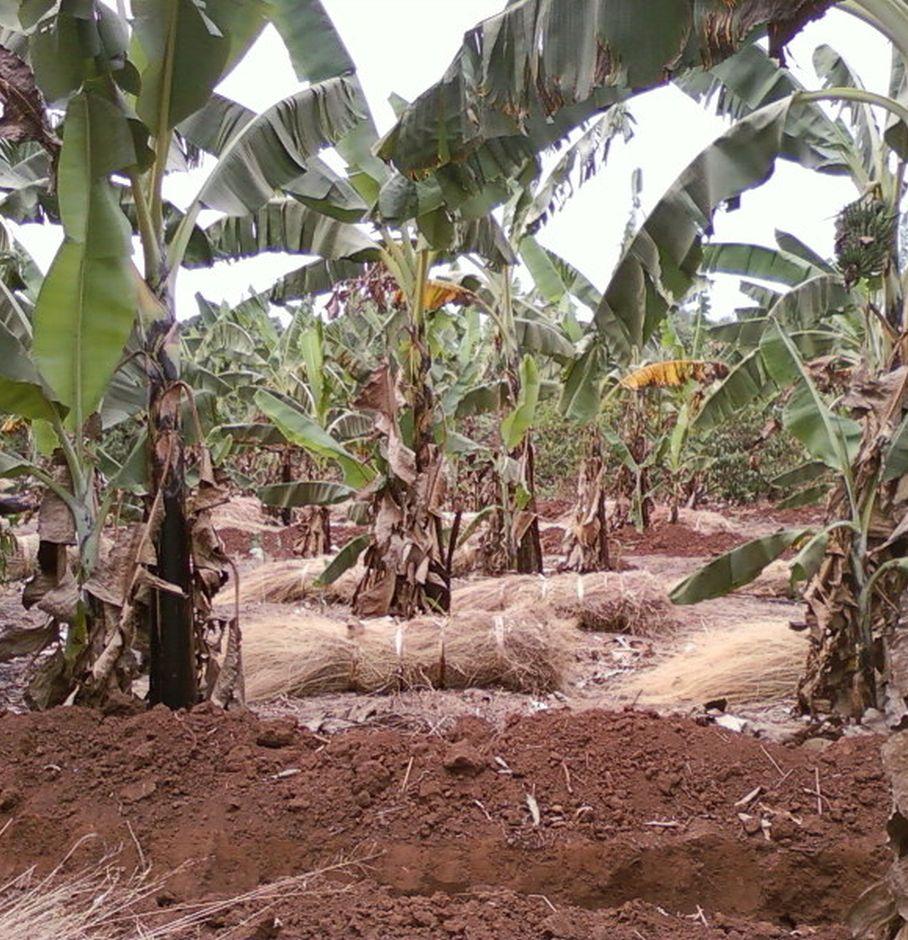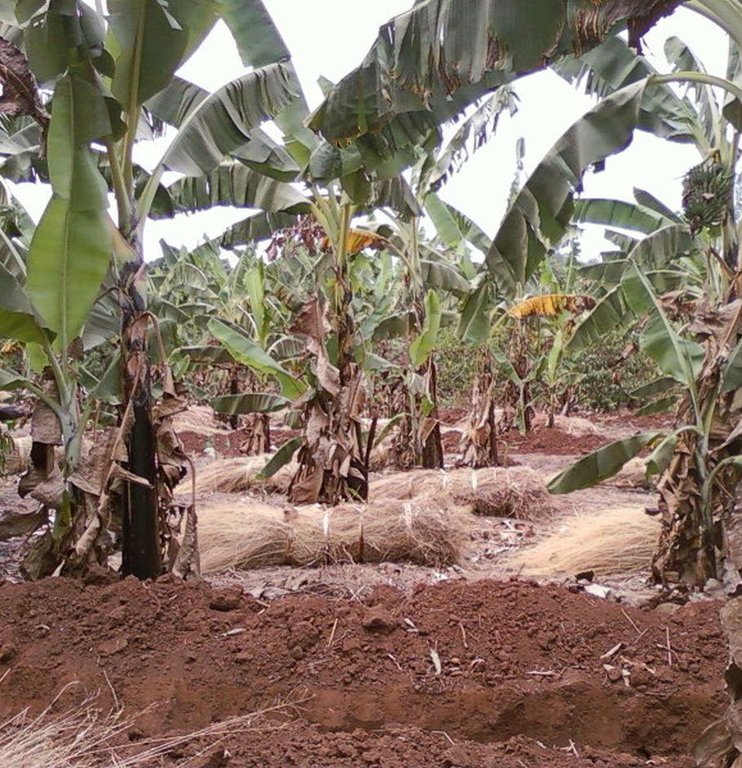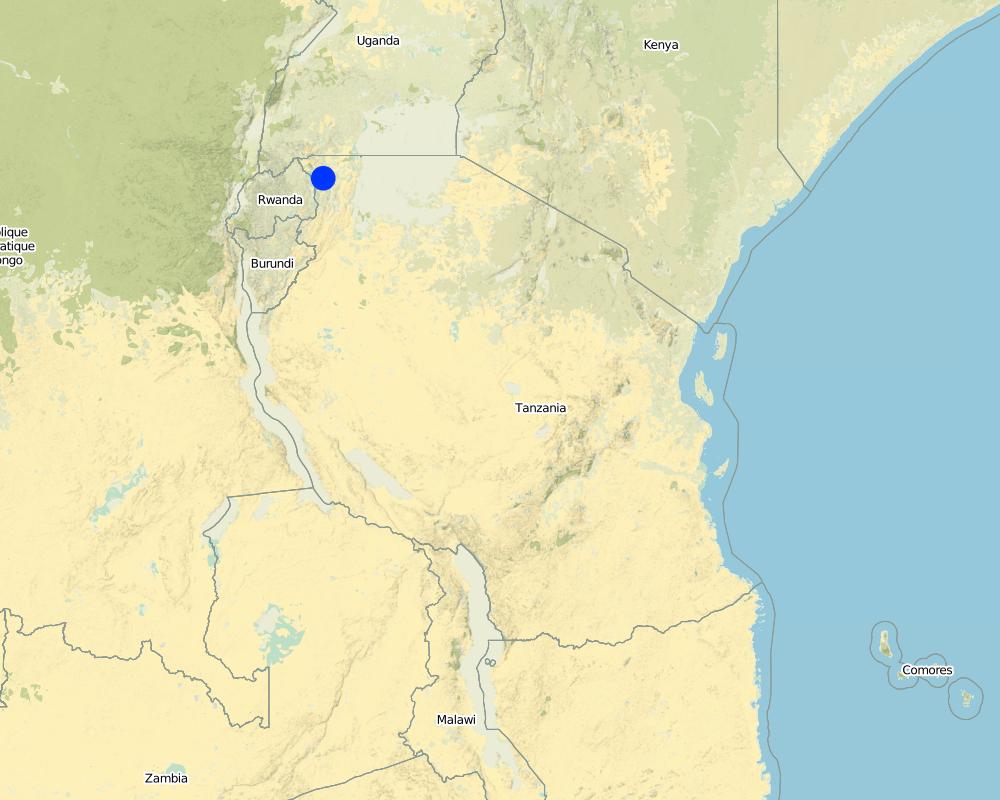Contour ditches combined with manures and mulch grass in banana production. [ប្រទេសតង់សានី]
- ការបង្កើត៖
- បច្ចុប្បន្នភាព
- អ្នកចងក្រង៖ Godfrey Baraba
- អ្នកកែសម្រួល៖ –
- អ្នកត្រួតពិនិត្យ David Streiff
makinga maji ya kati
technologies_1215 - ប្រទេសតង់សានី
ពិនិត្យមើលគ្រប់ផ្នែក
ពង្រីកមើលទាំងអស់ បង្រួមទាំងអស់1. ព័ត៌មានទូទៅ
1.2 ព័ត៌មានលម្អិតពីបុគ្គលសំខាន់ៗ និងស្ថាប័នដែលចូលរួមក្នុងការវាយតម្លៃ និងចងក្រងឯកសារនៃបច្ចេកទេស
អ្នកជំនាញឯកទេស SLM:
ឈ្មោះគម្រោងដែលបានចងក្រងឯកសារ/ វាយតម្លៃលើបច្ចេកទេស (បើទាក់ទង)
The Transboundary Agro-ecosystem Management Project for the Kagera River Basin (GEF-FAO / Kagera TAMP )ឈ្មោះអង្គភាពមួយ (ច្រើន) ដែលបានចងក្រងឯកសារ/ វាយតម្លៃបច្ចេកទេស (បើទាក់ទង)
Missenyi District Council (Missenyi District Council) - ប្រទេសតង់សានីឈ្មោះអង្គភាពមួយ (ច្រើន) ដែលបានចងក្រងឯកសារ/ វាយតម្លៃបច្ចេកទេស (បើទាក់ទង)
Bukoba district council (Bukoba district council) - ប្រទេសតង់សានី1.3 លក្ខខណ្ឌទាក់ទងទៅនឹងការប្រើប្រាស់ទិន្នន័យដែលបានចងក្រងតាមរយៈ វ៉ូខេត
តើពេលណាដែលទិន្នន័យបានចងក្រង (នៅទីវាល)?
30/07/2014
អ្នកចងក្រង និង(បុគ្គលសំខាន់ៗ)យល់ព្រមទទួលយកនូវលក្ខខណ្ឌនានាទាក់ទងទៅនឹងការប្រើប្រាស់ទិន្នន័យដែលបានចងក្រងតាមរយៈវ៉ូខេត:
បាទ/ចា៎
1.4 សេចក្តីប្រកាសស្តីពីចីរភាពនៃការពណ៌នាពីបច្ចេកទេស
តើបច្ចេកទេសដែលបានពណ៌នានេះមានបញ្ហាដែលផ្តោតលើការធ្លាក់ចុះគុណភាពដី, បើដូច្នេះវាមិនអាចត្រូវបានប្រកាសថាជាបច្ចេកទេសនៃការគ្រប់គ្រងប្រកបដោយចីរភាពទេ?
ទេ
2. ការពណ៌នាពីបច្ចេកទេស SLM
2.1 ការពណ៌នាដោយសង្ខេបពីបច្ចេកទេស
និយមន័យបច្ចេកទេស:
Is a cross slope berier characterised with 2m widith by 2m depth furrow, farm yard manures and grass mulch in banana production.
2.2 ការពណ៌នាលម្អិតពីបច្ចេកទេស
ការពណ៌នា:
The level ditches combined with farm trushlines, farm yard manure, and grass mulch technology in banana production is the digging of a furrow measured 2m wide by 2m deep along the contour in the banana plantation. The technology is applied on a perennial cropland by combining structural, vegetative and agronomic measures. The climatic zone is sub humid in a gentle to moderate slope with medium to deep loam clay soils. The hand cultivation is done manual using hand hoes in a mixed production system. The establishment procedures contour demarcation using a local made A-frame, digging a furrow along the contour, digging the banana holes spaced at 3.6m by 3.6m between the structures, mixing farm yard manure with top soils and planting banana suckers after restng the mixture for not less than 60 days. The maintenance procedures requires, weeding the field, desuckering, detrushing, planting beans, topical manure application, grass mulch application and filling the contour furrow with farm trushlines. The land ownership is individual not titled. This technology was introduced in 2012 by Kagera TAMP using the FFS methodology. In case of sensitive climatic extremities
Purpose of the Technology: The major purpose for technology application is reduced moisture stress, increased soil water retention, reduced soil erosion to increase crop productivity in a sustainable land management.
Establishment / maintenance activities and inputs: The establishment activities included; first to clear the field and demarcate the contour line using a local made A-frame done at the end of short rains. Second is to plough and harrow the field done in the early dry season. Third is to space and dig holes for planting banana suckers done in mid of dry season. Fourth is mixing farm yard manures with top soils and cover the hole for not less than sity days before planting, this is done in mid of dry spell. Fourth is to plant certified banana suckers done in late dry season. Fifth is to dig the contour ditch done in at the onset of long rainfall. The maintenance activities includes; first to weed the entire field done twice before the onset of rainfalls. Second is to apply farm yard manures concurrently with grass mulch done once in the late dry period. Third is to desucker and detrush banana plants done twice before planting beans. Fourth is to plant beans done once before the onset of long rainfalls.
Natural / human environment: The natural environment in the location is 750-1000 mm rainfalls, foots lopes valley floors landform, gentle slope, shallow to meium soil depth (50-80)cm and (80-120)cm characterised with two growing periods. The social economic persisting are small scale land users farming on( 0.5 to 2)ha per house hold. The land ownership is individual not titled while the water use rights is open access. The importance of off-farm incomes is less than 10% and the market orientation is mixed while soil cultivation is manual and livestock are not fed on farm residues.
2.3 រូបភាពនៃបច្ចេកទេស
2.5 ប្រទេស/តំបន់/ទីតាំងកន្លែង ដែលបច្ចេកទេសត្រូវបានអនុវត្ត និងបានគ្រប់ដណ្តប់ដោយការវាយតម្លៃនេះ
ប្រទេស:
ប្រទេសតង់សានី
តំបន់/រដ្ឋ/ខេត្ត:
Tanzania
បញ្ជាក់បន្ថែមពីលក្ខណៈនៃទីតាំង:
Karagwe District Council
Map
×2.6 កាលបរិច្ឆេទនៃការអនុវត្ត
ប្រសិនបើមិនច្បាស់ឆ្នាំ សូមបញ្ជាក់កាលបរិច្ឆេទដែលប្រហាក់ប្រហែល:
- តិចជាង 10ឆ្នាំមុន (ថ្មី)
2.7 ការណែនាំពីបច្ចេកទេស
សូមបញ្ជាក់តើបច្ចេកទេសត្រូវបានណែនាំឱ្យអនុវត្តដោយរបៀបណា:
- តាមរយៈគម្រោង / អន្តរាគមន៍ពីខាងក្រៅ
មតិយោបល់ (ប្រភេទនៃគម្រោង ។ល។):
Introduced by TAMP -Kagera, Tanzania in 2012 using FFS methodology.
3. ចំណាត់ថ្នាក់នៃបច្ចេកទេស SLM
3.1 គោលបំណងចម្បង (១ ឬច្រើន) នៃបច្ចេកទេសនេះ
- កាត់បន្ថយ, បង្ការ, ស្តារឡើងវិញនូវការធ្លាក់ចុះគុណភាពដី
3.2 ប្រភេទដីប្រើប្រាស់មួយប្រភេទ (ច្រើនប្រភេទ) ដែលបានអនុវត្តបច្ចេកទេស

ដីដាំដំណាំ
- ដំណាំប្រចាំឆ្នាំ
- ដំណាំរយៈពេលវែង (មិនមែនឈើ)
ដំណាំចម្បង (ដំណាំកសិ-ឧស្សាហកម្ម និងដំណាំស្បៀង) :
major cash crop: Beans and coffee
major food crop: Maize and banana
other: Sweet potatoes
មតិយោបល់:
Major land use problems (compiler’s opinion): The major land use problem related to soil and vegetation in the area were soil erosion, soil moisture stress and fertility decline and reduced organic matter content.
Major land use problems (land users’ perception): moisture stresss and soil erosion.
3.3 ព័ត៌មានបន្ថែមអំពីអ្នកប្រើប្រាស់ដី
ការផ្គត់ផ្គង់ទឹកនៅកន្លែងអនុវត្តបច្ចេកទេស:
- ទឹកភ្លៀង
ចំនួនសារដែលដាំដំណាំក្នុងមួយឆ្នាំ:
- 2
សូមបញ្ជាក់:
Longest growing period in days: 90; Longest growing period from month to month: October to December; Second longest growing period in days: 60; Second longest growing period from month to month: March to May
3.4 ក្រុម SLM ដែលបច្ចេកទេសស្ថិតនៅក្នុង
- ធ្វើឱ្យប្រសើរឡើងគម្របដី/ ដំណាំគម្របដី
- ការគ្រប់គ្រងជីជាតិដីតាមបែបចម្រុះ
3.5 ការសាយភាយនៃបច្ចេកទេស
បញ្ជាក់ពីការសាយភាយនៃបច្ចេកទេស:
- ត្រូវបានផ្សព្វផ្សាយត្រឹមតំបន់មួយ
ប្រសិនបើបច្ចេកទេសត្រូវបានសាយភាយពាសពេញតំបន់ណាមួយ សូមកំណត់ទំហំផ្ទៃដីអនុវត្តន៍:
- < 0.1 គម2 (10 ហិកតា)
មតិយោបល់:
Three host farmers of FFS allocated a total of 1.5 acres (three different sites) as a leaning sites. While 22 group members implimented the technology with modifications in their farms with average of 0.5ha X22 =1.1ha
3.6 វិធានការ SLM ដែលបញ្ចូលនូវបច្ចេកទេស

វិធានការក្សេត្រសាស្ត្រ
- A2: សារធាតុសរីរាង្គ/ជីជាតិដី
- A3: ការរក្សាស្រទាប់ដីខាងលើ

វិធានការរុក្ខជាតិ
- V5: ផ្សេងៗ

វិធានការរចនាស័ម្ពន្ធ
- S2: ភ្លឺ ច្រាំង
មតិយោបល់:
Specification of other vegetative measures: lemon grass
Type of agronomic measures: better crop cover, mulching, temporary trashlines, manure / compost / residues
Type of vegetative measures: aligned: -contour, scattered / dispersed
3.7 កំណត់ប្រភេទនៃការធ្លាក់ចុះគុណភាពដីសំខាន់ៗដែលបច្ចេកទេសនេះបានដោះស្រាយ

ការហូរច្រោះដីដោយសារទឹក
- Wt: ការបាត់ដីស្រទាប់លើដោយការហូរច្រោះ

ការធ្លាក់ចុះសារធាតុគីមីក្នុងដី
- Cn: ការថយចុះជីជាតិ និងកាត់បន្ថយបរិមាណសារធាតុសរីរាង្គ (មិនកើតឡើងដោយការហូរច្រោះទេ)

ការធ្លាក់ចុះជីវសាស្ត្រនៃដី
- Bl: ការបាត់បង់មីក្រូ និងម៉ាក្រូសរីរាង្គរបស់ដី
មតិយោបល់:
Main causes of degradation: soil management (cultivating along the slopes), crop management (annual, perennial, tree/shrub) (continous banana production without soil fertilization.), change of seasonal rainfall (dry spell prolonged), droughts (the area experienced a six months dry period.), population pressure (High population growth rates had forced to cultivate slope lands to feed the population.), poverty / wealth (community cant afford to invest in soil conservation.), education, access to knowledge and support services (inadequate staffing reduces extension services rendered to farmes.), governance / institutional (Agriculture policy had a narrow focus on environmental issues.)
3.8 ការពារ កាត់បន្ថយ ឬស្តារឡើងវិញនៃការធ្លាក់ចុះគុណភាពដី
បញ្ជាក់ពីគោលដៅរបស់បច្ចេកទេស ដែលផ្តោតទៅការធ្លាក់ចុះគុណភាពដី:
- ការការពារការធ្លាក់ចុះគុណភាពដី
- ការកាត់បន្ថយការធ្លាក់ចុះគុណភាពដី
4. បច្ចេកទេសជាក់លាក់ សកម្មភាពអនុវត្ត ធាតុចូល និងថ្លៃដើម
4.2 លក្ខណៈពិសេសនៃបច្ចេកទេស/ ពណ៌នាពីគំនូរបច្ចេកទេស
Technical knowledge required for field staff / advisors: low (Basic agronomy principles, farm structures and vegetation management are taught at colleges.)
Technical knowledge required for land users: low (most of material required to implement the technology are common to them.)
Main technical functions: control of raindrop splash, control of dispersed runoff: retain / trap, control of dispersed runoff: impede / retard, improvement of ground cover, stabilisation of soil (eg by tree roots against land slides), increase in organic matter, increase in nutrient availability (supply, recycling,…), increase of infiltration, increase / maintain water stored in soil, increase of biomass (quantity)
Better crop cover
Material/ species: Pumpukins and water melon
Remarks: spaced at 3m in the space between the contour bunds.
Mulching
Material/ species: hyperhamia spps
Quantity/ density: 1500
Remarks: spread across the slope with 15cm thick covering the soil surfaces where banana and coffee are plant
Temporary trashlines
Material/ species: banana dry leaves and psodstems.
Manure / compost / residues
Material/ species: farm yard manures
Quantity/ density: 48979
Remarks: 60kg per plant during planting and 36kg for maintenance.
Aligned: -contour
Vegetative material: G : grass
Number of plants per (ha): 1666
Spacing between rows / strips / blocks (m): 18
Vertical interval within rows / strips / blocks (m): 0.6
Width within rows / strips / blocks (m): 0.3
Scattered / dispersed
Vegetative material: O : other
Number of plants per (ha): 778
Structural measure: contour bund
Spacing between structures (m): 18
Depth of ditches/pits/dams (m): 0.6
Width of ditches/pits/dams (m): 0.6
Length of ditches/pits/dams (m): 100
Height of bunds/banks/others (m): 0.3
Width of bunds/banks/others (m): 0.6
Length of bunds/banks/others (m): 100
Construction material (earth): soils excavated from the furrow.
4.3 ព័ត៌មានទូទៅដែលពាក់ព័ន្ធនឹងការគណនាធាតុចូល និងថ្លៃដើម
កំណត់រូបិយប័ណ្ណសម្រាប់ថ្លៃដើម:
- ដុល្លារអាមេរិក
កំណត់ថ្លៃឈ្នួលជាមធ្យមនៃការជួលកម្លាំងពលកម្មក្នុងមួយថ្ងៃ:
2.64
4.4 សកម្មភាពបង្កើត
| សកម្មភាព | ប្រភេទវិធានការ | ពេលវេលា | |
|---|---|---|---|
| 1. | To plant lemon grass | សារពើរុក្ខជាតិ | March |
| 2. | To plant water melon | សារពើរុក្ខជាតិ | april |
| 3. | To gape fill lemon grasse | សារពើរុក្ខជាតិ | september |
| 4. | Dermacating the contour lines using simple made tool (A-frame) | រចនាសម្ព័ន្ធ | June |
| 5. | To dig a furrow and excavating the soils to be placed on either lower side or upper side of the furrow. | រចនាសម្ព័ន្ធ | August |
4.5 ថ្លៃដើម និងធាតុចូលដែលត្រូវការសម្រាប់ការបង្កើតបច្ចេកទេស
| បញ្ជាក់ពីធាតុចូល | ឯកតា | បរិមាណ | ថ្លៃដើមក្នុងមួយឯកតា | ថ្លៃធាតុចូលសរុប | % នៃថ្លៃដើមដែលចំណាយដោយអ្នកប្រើប្រាស់ដី | |
|---|---|---|---|---|---|---|
| កម្លាំងពលកម្ម | Labour | ha | 1,0 | 609,45 | 609,45 | |
| សម្ភារៈ | Tools | ha | 1,0 | 114,71 | 114,71 | |
| សម្ភារៈដាំដុះ | Seedlings | ha | 1,0 | 420,17 | 420,17 | |
| ជី និងសារធាតុពុល | Compost / manure | ha | 1,0 | 756,3 | 756,3 | |
| ថ្លៃដើមសរុបក្នុងការបង្កើតបច្ចេកទេស | 1900,63 | |||||
មតិយោបល់:
Duration of establishment phase: 12 month(s)
4.6 សកម្មភាពថែទាំ
| សកម្មភាព | ប្រភេទវិធានការ | ពេលវេលា/ ភាពញឹកញាប់ | |
|---|---|---|---|
| 1. | Weeding in the space where coffee and banana are planted. | ក្សេត្រសាស្ត្រ | january and June |
| 2. | desuckering | ក្សេត្រសាស្ត្រ | February and August |
| 3. | Detrushing | ក្សេត្រសាស្ត្រ | February and August |
| 4. | manure application | ក្សេត្រសាស្ត្រ | July |
| 5. | Spreading mulch grasses | ក្សេត្រសាស្ត្រ | September |
| 6. | Harvesting banana and coffee. | ក្សេត្រសាស្ត្រ | routeenly |
| 7. | To harvest lemon grass | សារពើរុក្ខជាតិ | routeenly |
| 8. | To remove soil sedments from the furrow and place them along the contour lines. | រចនាសម្ព័ន្ធ | june and January. |
4.7 កំណត់ថ្លៃដើមសម្រាប់ការថែទាំ/ សកម្មភាពរបស់បច្ចេកទេស (ក្នុងរយៈពេលមួយឆ្នាំ)
| បញ្ជាក់ពីធាតុចូល | ឯកតា | បរិមាណ | ថ្លៃដើមក្នុងមួយឯកតា | ថ្លៃធាតុចូលសរុប | % នៃថ្លៃដើមដែលចំណាយដោយអ្នកប្រើប្រាស់ដី | |
|---|---|---|---|---|---|---|
| កម្លាំងពលកម្ម | Labour | ha | 1,0 | 416,91 | 416,91 | 100,0 |
| សម្ភារៈដាំដុះ | Seeds | ha | 1,0 | 88,24 | 88,24 | 100,0 |
| ជី និងសារធាតុពុល | Compost / manure | ha | 1,0 | 252,1 | 252,1 | 100,0 |
| ជី និងសារធាតុពុល | Grass mulch | ha | 1,0 | 441,18 | 441,18 | 100,0 |
| ថ្លៃដើមសរុបសម្រាប់ការថែទាំដំណាំតាមបច្ចេកទេស | 1198,43 | |||||
មតិយោបល់:
Labour calculated per ha of land protected, Farm yard manure calculated per plants applied, mulch grass calculated per ha of land protected, seedling and seeds calculated per ha of land protected.
4.8 កត្តាសំខាន់បំផុតដែលមានឥទ្ធិពលដល់ការចំណាយ
ពណ៌នាពីកត្តាប៉ះពាល់ចម្បងៗទៅលើថ្លៃដើម:
The most determinate factor affecting the cost is labour
5. លក្ខណៈបរិស្ថានធម្មជាតិ និងមនុស្ស
5.1 អាកាសធាតុ
បរិមាណទឹកភ្លៀងប្រចាំឆ្នាំ
- < 250 មម
- 251-500 មម
- 501-750 មម
- 751-1,000 មម
- 1,001-1,500 មម
- 1,501-2,000 មម
- 2,001-3,000 មម
- 3,001-4,000 មម
- > 4,000 មម
តំបន់កសិអាកាសធាតុ
- មានភ្លៀងមធ្យម
Thermal climate class: tropics
5.2 សណ្ឋានដី
ជម្រាលជាមធ្យម:
- រាបស្មើ (0-2%)
- ជម្រាលតិចតួច (3-5%)
- មធ្យម (6-10%)
- ជម្រាលខ្ពស់បន្តិច (11-15%)
- ទីទួល (16-30%)
- ទីទួលចោត (31-60%)
- ទីទួលចោតខ្លាំង (>60%)
ទម្រង់ដី:
- ខ្ពង់រាប
- កំពូលភ្នំ
- ជម្រាលភ្នំ
- ជម្រាលទួល
- ជម្រាលជើងភ្នំ
- បាតជ្រលងភ្នំ
តំបន់តាមរយៈកម្ពស់ :
- 0-100 ម
- 101-500 ម
- 501-1,000 ម
- 1,001-1,500 ម
- 1,501-2,000 ម
- 2,001-2,500 ម
- 2,501-3,000 ម
- 3,001-4,000 ម
- > 4,000 ម
5.3 ដី
ជម្រៅដីជាមធ្យម:
- រាក់ខ្លាំង (0-20 សម)
- រាក់ (21-50 សម)
- មធ្យម (51-80 សម)
- ជ្រៅ (81-120 សម)
- ជ្រៅខ្លាំង (> 120 សម)
វាយនភាពដី (ស្រទាប់លើ):
- មធ្យម (ល្បាយ, ល្បាប់)
សារធាតុសរីរាង្គនៅស្រទាប់ដីខាងលើ:
- មធ្យម (1-3%)
បើអាចសូមភ្ជាប់ការពណ៌នាពីដីឱ្យបានច្បាស់ ឬព័ត៌មានដែលអាចទទួលបាន ឧ. ប្រភេទដី, pH ដី/ ជាតិអាស៊ីត, សមត្ថភាពផ្លាស់ប្តូរកាចុង, វត្តមាននីត្រូសែន, ភាពប្រៃ ។ល។:
Soil fertility is medium
Soil drainage / infiltration is medium
Soil water storage capacity is medium
5.4 ទឹកដែលអាចទាញមកប្រើប្រាស់បាន និងគុណភាពទឹក
ទឹកលើដីដែលអាចទាញយកប្រើប្រាស់បាន:
លើស
គុណភាពទឹក (មិនបានធ្វើប្រត្តិកម្ម):
ទឹកពិសារដែលមានគុណភាពល្អ
មតិយោបល់ និងលក្ខណៈពិសេសផ្សេងៗទៀតលើគុណភាព និងបរិមាណទឹក :
Availability of surface water: Excess during short rainfals and medium because two permanent river tributaries (misheke and Charuhanga) flows throughout the year.
Water quality (untreated): Good drinking water when gravity water supply from Kasunkuni river tributar and poor when over-flooded Mwisa river during short rains.
5.5 ជីវៈចម្រុះ
ភាពសម្បូរបែបនៃប្រភេទ:
- កម្រិតមធ្យម
មតិយោបល់ និងលក្ខណៈពិសេសផ្សេងទៀតលើជីវចម្រុះ:
Mchwa, sisimizi, vipepeo and earth worms
5.6 លក្ខណៈនៃអ្នកប្រើប្រាស់ដីដែលអនុវត្តបច្ចេកទេស
ទីផ្សារនៃប្រព័ន្ធផលិតកម្ម:
- ពាក់កណ្តាលពាណិជ្ជកម្ម (ផ្គត់ផ្គង់ខ្លួនឯង/ ពាណិជ្ជកម្ម
ចំណូលក្រៅកសិកម្ម:
- តិចជាង 10% នៃចំណូល
កម្រិតជីវភាព:
- មិនល្អ
- មធ្យម
ឯកជន ឬក្រុម:
- ធ្វើខ្លួនឯង/ គ្រួសារ
កម្រិតប្រើប្រាស់គ្រឿងយន្ត:
- ប្រើកម្លាំងពលកម្ម
យេនឌ័រ:
- ស្ត្រី
- បុរស
សូមបញ្ជាក់ពីលក្ខណៈពាក់ព័ន្ធផ្សេងទៀតអំពីអ្នកប្រើប្រាស់ដី:
Land users applying the Technology are mainly common / average land users
Population density: 50-100 persons/km2
Annual population growth: < 0.5%
99% of the land users are average wealthy and own 100% of the land.
1% of the land users are poor.
Off-farm income specification: Land users who applied the technolgy can meet hie/her cost of living (mainly food) from farm income while land users who have not applied the technology can not the household cost of living from the farm.
Market orientation of production system: Coffee are for sale while banana only excess is for sale.
Level of mechanization: Hand hoes use during farm establishment, but late local made tool (vihosho) are used for weeding and desuckering purpoes.
5.7 ទំហំផ្ទៃដីជាមធ្យមនៃដីផ្ទាល់ខ្លួន ឬជួលគេដែលបានអនុវត្តបច្ចេកទេស
- < 0.5 ហិកតា
- 0.5-1 ហិកតា
- 1-2 ហិកតា
- 2-5 ហិកតា
- 5-15 ហិកតា
- 15-50 ហិកតា
- 50-100 ហិកតា
- 100-500 ហិកតា
- 500-1,000 ហិកតា
- 1,000-10,000 ហិកតា
- > 10,000 ហិកតា
តើផ្ទៃដីនេះចាត់ទុកជាទំហំកម្រិតណាដែរ ខ្នាតតូច មធ្យម ឬខ្នាតធំ (ធៀបនឹងបរិបទតំបន់)?
- ខ្នាតតូច
មតិយោបល់:
< 0.5 and 0.5-1 ha: 75 % of landusers
2-5 ha: 25 percent of landusers
5.8 ភាពជាម្ចាស់ដី កម្មសិទ្ធប្រើប្រាស់ដី និងកម្មសិទ្ធប្រើប្រាស់ទឹក
ភាពជាម្ចាស់ដី:
- ឯកជន មិនមានកម្មសិទ្ធ
កម្មសិទ្ធិប្រើប្រាស់ដី:
- ជាក្រុម (មានដែនកំណត់)
- ឯកជន
កម្មសិទ្ធប្រើប្រាស់ទឹក:
- អាស្រ័យផលសេរី (មិនមានការកំណត់)
5.9 ការប្រើប្រាស់សេវាកម្ម និងហេដ្ឋារចនាសម្ព័ន្ធ
សុខភាព:
- មិនល្អ
- មធ្យម
- ល្អ
ការអប់រំ:
- មិនល្អ
- មធ្យម
- ល្អ
ជំនួយបច្ចេកទេស:
- មិនល្អ
- មធ្យម
- ល្អ
ការងារ (ឧ. ការងារក្រៅកសិដ្ឋាន):
- មិនល្អ
- មធ្យម
- ល្អ
ទីផ្សារ:
- មិនល្អ
- មធ្យម
- ល្អ
ថាមពល:
- មិនល្អ
- មធ្យម
- ល្អ
ផ្លូវ និងការដឹកជញ្ជូន:
- មិនល្អ
- មធ្យម
- ល្អ
ទឹកផឹក និងអនាម័យ:
- មិនល្អ
- មធ្យម
- ល្អ
សេវាកម្មហិរញ្ញវត្ថុ:
- មិនល្អ
- មធ្យម
- ល្អ
6. ផលប៉ះពាល់ និងការសន្និដ្ឋាន
6.1 ផលប៉ះពាល់ក្នុងបរិវេណអនុវត្តបច្ចេកទេសដែលកើតមាន
ផលប៉ះពាល់លើសេដ្ឋកិច្ចសង្គម
ផលិតផល
ផលិតកម្មដំណាំ
មតិយោបល់/ ការបញ្ជាក់:
Not yet harvested the first yield
ហានិភ័យនៃភាពបរាជ័យរបស់ផលិតកម្ម
មតិយោបល់/ ការបញ្ជាក់:
Mulch grass have reduced moisture stresses
ចំណូល និងថ្លៃដើម
ការចំណាយលើធាតុចូលកសិកម្ម
មតិយោបល់/ ការបញ្ជាក់:
Farm yard manures, mulch grasses, lemon seedlings, certified banana suckers and water melon seed
ភាពសម្បូរបែបប្រភពប្រាក់ចំណូល
មតិយោបល់/ ការបញ្ជាក់:
Lemon grasses and pumpukins sales
បន្ទុកការងារ
មតិយោបល់/ ការបញ្ជាក់:
Additional activies should demamnd more labours
ផលប៉ះពាល់ទៅលើវប្បធម៌សង្គម
សន្តិសុខស្បៀង/ ភាពគ្រប់គ្រាន់ខ្លួនឯង
មតិយោបល់/ ការបញ្ជាក់:
Increased food production should ensure availability, while sale of coffee should ensure accebility to balance the diet
ស្ថាប័នសហគមន៍
មតិយោបល់/ ការបញ្ជាក់:
FFS group members
ស្ថាប័នជាតិ
មតិយោបល់/ ការបញ្ជាក់:
Out-soucing of activities to TCRA
ចំណេះដឹង SLM / ការធ្លាក់ចុះគុណភាពដី
មតិយោបល់/ ការបញ្ជាក់:
Udelt learning using FFS methodology
ស្ថានភាពក្រុមដែលមានបញ្ហាក្នុងសង្គម និងសេដ្ឋកិច្ច
មតិយោបល់/ ការបញ្ជាក់:
Three group members have no land, male and female have equal chances in the group
ផលប៉ះពាល់ទៅលើអេកូឡូស៊ី
វដ្តទឹក/លំហូរ
លំហូរទឹកលើផ្ទៃដី
មតិយោបល់/ ការបញ្ជាក់:
Mulch grasses and contour bung
រំហួត
មតិយោបល់/ ការបញ្ជាក់:
Mulch grasses
ដី
សំណើមដី
មតិយោបល់/ ការបញ្ជាក់:
Mulch grasses
គម្របដី
មតិយោបល់/ ការបញ្ជាក់:
Mulch grass and pumpukins
ការបាត់បង់ដី
មតិយោបល់/ ការបញ្ជាក់:
Lemon grasse planted along the contour bunds
សារធាតុសរីរាង្គដី/ការបូនក្រោមដី
មតិយោបល់/ ការបញ្ជាក់:
Farm yard manures application
ជីវចម្រុះ៖ ដំណាំ, សត្វ
ជីវម៉ាស/ កាបូនលើដី
មតិយោបល់/ ការបញ្ជាក់:
Mulch grass and trushlines
ការគ្រប់គ្រងកត្តាចង្រៃ/ ជំងឺ
មតិយោបល់/ ការបញ្ជាក់:
Use of certicefid banana suckers
ការកាត់បន្ថយហានិភ័យនៃគ្រោះមហន្តរាយ និងគ្រោះអាកាសធាតុ
ហានិភ័យនៃភ្លើងឆេះព្រៃ
មតិយោបល់/ ការបញ្ជាក់:
Attention for grasses collection before fire seting on has increased
6.2 ផលប៉ះពាល់ក្រៅបរិវេណអនុវត្តបច្ចេកទេសដែលកើតមាន
ខូចខាតដល់ស្រែអ្នកជិតខាង
មតិយោបល់/ ការបញ្ជាក់:
Water run-off reduction
ខូចខាតដល់ហេដ្ឋារចនាសម្ព័ន្ធសាធារណៈ/ឯកជន
មតិយោបល់/ ការបញ្ជាក់:
No longer concentrated run-off
6.3 ភាពប្រឈម និងភាពរួសនៃបច្ចេកទេសទៅនឹងការប្រែប្រួលអាកាសធាតុ និងគ្រោះអាកាសធាតុ/ គ្រោះមហន្តរាយ (ដែលដឹងដោយអ្នកប្រើប្រាស់ដី)
គ្រោះអាកាសធាតុ (មហន្តរាយ)
គ្រោះមហន្តរាយធម្មជាតិ
| លក្ខណៈឆ្លើយតបនៃបច្ចេកទេសទៅនឹងការប្រែប្រួលអាកាសធាតុ | |
|---|---|
| ព្យុះភ្លៀងតាមតំបន់ | មិនល្អ |
គ្រោះមហន្តរាយអាកាសធាតុ
| លក្ខណៈឆ្លើយតបនៃបច្ចេកទេសទៅនឹងការប្រែប្រួលអាកាសធាតុ | |
|---|---|
| រាំងស្ងួត | ល្អ |
មតិយោបល់:
The technology can be modified of metre drain and the collected water to be used for small scale irrigation.
6.4 ការវិភាគថ្លៃដើម និងអត្ថប្រយោជន៍
តើផលចំណេញ និងថ្លៃដើមត្រូវបានប្រៀបធៀបគ្នាយ៉ាងដូចម្តេច (ទស្សនៈរបស់អ្នកប្រើប្រាស់ដី)?
រយៈពេលខ្លី:
ប៉ះពាល់តិចតួចបំផុត
រយៈពេលវែង:
វិជ្ជមានខ្លាំង
តើផលចំណេញ និងការថែទាំ/ ជួសជុលត្រូវបានប្រៀបធៀបគ្នាយ៉ាងដូចម្តេច (ទស្សនៈរបស់អ្នកប្រើប្រាស់ដី)?
រយៈពេលខ្លី:
អវិជ្ជមាន
រយៈពេលវែង:
វិជ្ជមាន
មតិយោបល់:
In the short term returns banana harvested should equate the establishment costs, while in the long term retuns there will be no further establishment, therefore returns are very positive.
in the short term retuns negative compared to maintenance because all returns equate establishment costs, while in the longterm returns should be positive due to complimentary effects of protected land to improve productivity.
6.5 ការទទួលយកបច្ចេកទេស
- ច្រើនជាង 50%
បើអាច សូមបញ្ជាក់ពីបរិមាណ (ចំនួនគ្រួសារ និង/ ឬតំបន់គ្របដណ្តប់):
70 households in an area of 10 ha
ក្នុងចំណោមគ្រួសារទាំងអស់ដែលអនុវត្តបច្ចេកទេស តើមានប៉ុន្មានគ្រួសារដែលចង់ធ្វើដោយខ្លួនឯង ដោយមិនទទួលបានសម្ភារៈលើកទឹកចិត្ត/ប្រាក់ឧបត្ថម្ភ?:
- 10-50%
មតិយោបល់:
35 land user families have adopted the Technology with external material support
Comments on acceptance with external material support: Three host farmers were provided with farm yard manures and mulch grasses.
35 land user families have adopted the Technology without any external material support
Comments on spontaneous adoption: The FFS started late due to inadequate council staffing.
There is no trend towards spontaneous adoption of the Technology
Comments on adoption trend: Still early to give any comments (actual implimentation started September 2013.
6.7 ភាពខ្លាំង/ គុណសម្បត្តិ/ ឱកាសនៃបច្ចេកទេស
| ភាពខ្លាំង/ គុណសម្បត្តិ/ ឱកាស ទស្សនៈរបស់បុគ្គលសំខាន់ៗ |
|---|
| The technology is easy to learn and simple to implement. |
| Production results are of short gestation period when considering test crop (banana) for land users to make the decisions. |
6.8 ភាពខ្សោយ/ គុណវិបត្តិ/ ហានិភ័យនៃបច្ចេកទេស និងវិធីសាស្ត្រដោះស្រាយ
| ភាពខ្សោយ/ គុណវិបត្តិ/ ហានិភ័យ ទស្សនៈរបស់អ្នកចងក្រងឬបុគ្គលសំខាន់ៗ | តើបច្ចេកទេសទាំងនោះបានដោះស្រាយបញ្ហាដូចម្តេច? |
|---|---|
| The technology increased the farm input (farm yard manures and grass mulch) costs of which average land users (peasants) can not afford from his farm income on top of meeting his daily cost of living. | Introduce zero grazing to provide farm yard manures and quick income generating activities. |
| Big land area is require to realise the ecological benefits. | Sensitize political will to stimulate and support technology up scaling through multiplier effects. |
7. ឯកសារយោង និងវេបសាយ
7.1 វិធីសាស្ត្រ/ ប្រភពនៃព័ត៌មាន
- តាមការចុះទីវាល ការស្រាវជ្រាវនៅទីវាល
- ការសម្ភាសន៍ជាមួយអ្នកប្រើប្រាស់ដី
ការតភ្ជាប់ និងម៉ូឌុល
ពង្រីកមើលទាំងអស់ បង្រួមទាំងអស់ការតភ្ជាប់
គ្មានការតភ្ជាប់
ម៉ូឌុល
គ្មានម៉ូឌុល




